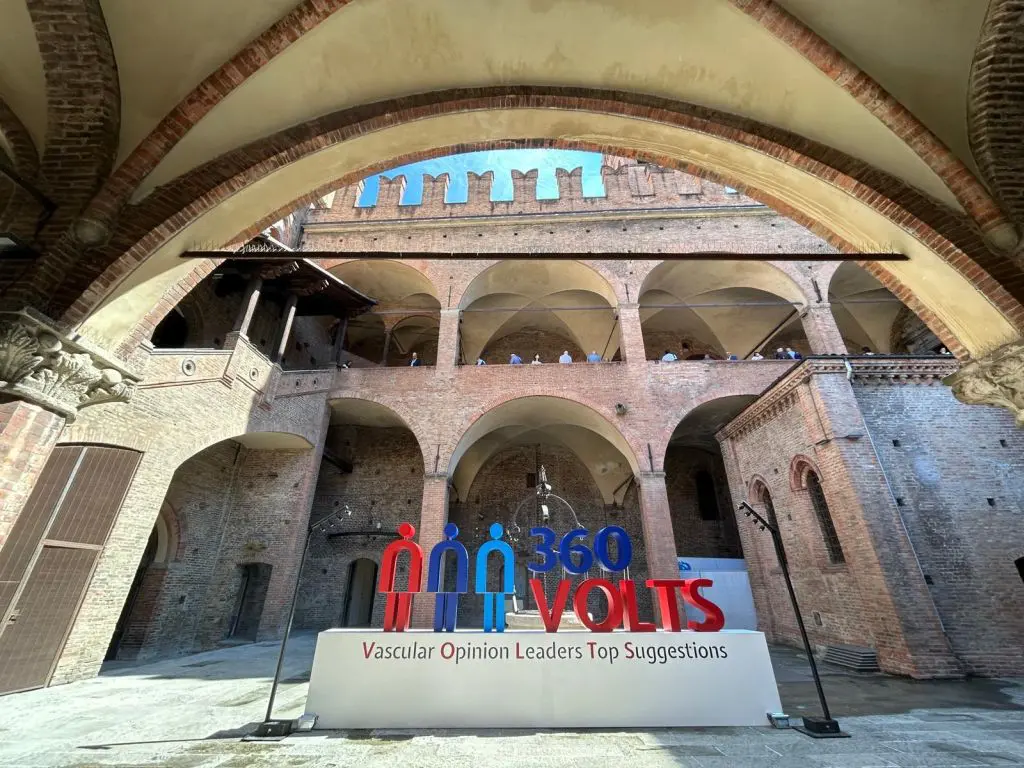BOLOGNA (ITALPRESS) – The first edition of 360 VOLTS – Vascular Opinion Leaders Top Suggestions, a CME event that brought together at Palazzo Re Enzo in Bologna, Italy, and via streaming link, some 200 specialists in the field of vascular medicine from all over Italy to explore the latest trends, best practices, emerging challenges and opportunities that are reshaping the landscape of care in the field of chronic venous disease, has concluded.A true 360-degree update that involved the presidents of the leading vascular societies involved in phlebolymphology, focusing on several topics: from cardiovascular risk in chronic venous disease and the urgency of raising awareness in the general adult population about the risks associated with the progression of chronic venous disease, to the appropriateness of interventions in phlebolymphology, the importance of bacterial biofilm in ulcers that do not heal, and the clinical challenge of correct long-term prognostic framing of the patient with chronic venous disease.Composing the scientific board: Romeo Martini, Angiology AULSS1 Dolomiti and president of the Italian Society of Angiology and Vascular Pathology (SIAPAV); Roberto Di Mitri, Scientific Director of the San Rossore Nursing Home (Pisa) and president of the Italian Phlebology Society (SIF); Maurizio Pagano, President of the Italian Phlebology Lymphology Society (SIFL); Angelo Santoliquido, Director of the UOSD Angiology and Non-Invasive Vascular Diagnostics IRCSS Policlinico Universitario Agostino Gemelli and president of the Italian College of Phlebology (CIF); Pier Luigi Antignani, Specialist in Medical Angiology and president of the Italian Society of Vascular Medicine (SIMV); and Gaetano Lanza, Professor at the Catholic University of the Sacred Heart and president of the Italian Society of Vascular and Endovascular Surgery (SICVE).Also collaborating on the faculty were Giovanni Papa, UCO Director of Plastic Surgery ASUGI Trieste, President of the Association of Skin Ulcers (AIUC) and Sergio Gianesini, Em. President v-WIN foundation and President International Union of Phlebology (IUP).This first edition of 360 VOLTS was made possible thanks to the unconditional support of Alfasigma, an Italian pharmaceutical company that is committed to providing patients, caregivers and healthcare professionals with state-of-the-art solutions according to the highest standards of quality and safety, including through targeted investments in the continuing education of professionals in the field.Chronic venous disease has a marked prevalence among women and is a chronic and progressive disease that commonly begins in the warm season with a typical symptomatic pattern (swollen, heavy, aching legs) and often progresses over the years in varicose form, but can reach more severe stages such as edema, skin changes and up to venous ulcerations, especially in the presence of risk factors (ex. obesity), comorbidities, or if phlebo-thrombotic complications intervene along the natural history of the disease.The large population of people with chronic venous disease nationwide also includes groups that are at higher risk for progression to the severe stages of the disease. Prominent among the aggravating risk factors for chronic venous disease are patients with high body weight index (overweight and obesity), the elderly, and postmenopausal women, especially those with more than two pregnancies in their personal history.Technological innovation, emerging therapies, and strategies to improve access and quality of care were the focus of the program, which addressed the most relevant clinical issues in chronic venous disease.These included exploring the role of the endothelium, a tissue that functions to line the inside of the walls of the heart, blood vessels, and lymphatic vessels,6 from the macro to the micro-circulation.According to the CIF Guidelines and ESVS Guidelines, the endothelial role in chronic venous disease has become increasingly important over the past two decades for the full understanding of the pathophysiologic mechanisms underlying a disease that by definition is chronic and progressive. In particular, it is endothelial inflammation secondary to venous hypertension that is the recurrent and chronic event linking venous insufficiency to endothelial dysfunction in chronic venous disease, constituting the pair of therapeutic targets on which medical and surgical treatments are focused.Among the topics focused on, which has important implications for clinical practice, are risk profiles in venous disease, with the framing of clinical signs and symptoms according to the CEAP scale and the assessment of risk factors and comorbidities.Long-term prognostic framing of the patient with chronic venous disease remains, in fact, still an open clinical challenge, which depends on individual risk profiles that only in recent years have begun to be studied to weigh their association with the progression of venous disease. A review summarized the results of The Edinburgh Vein Study survey of 1566 adult patients (18-64 yr.) with chronic venous disease monitored for 13 years, reporting that 1/3 of patients with varicose veins develop signs of severe venous pathology with skin changes and an increased risk of ulceration. Specifically, risk factors included age, family history of varicose veins, previous thrombotic episodes, overweight and obesity, and presence of superficial reflux, all of which may influence the risk of progression of chronic venous disease.Chronic venous disease from symptom onset to thrombotic risk was discussed to focus attention on the urgency of raising awareness among the general adult population about the risks associated with the progression of chronic venous disease. The Gutenberg population-based study of more than 12,000 patients with chronic venous disease, conducted between 2012 and 2017, highlights that the most severe stages, ranging from edema to chronic venous ulcers, collectively termed IVC, are associated with an increased risk of developing 10-year cardiovascular disease. This highlights the importance of clinical care of the patient from the earliest stages of the disease with regular monitoring over time, as well as thorough patient assessment with careful definition of risk factors and comorbidities.An important chapter was skin lesions and venous ulcers. Difficult wounds and chronic ulcers that do not heal represent the main clinical challenge for all specialists involved in the management of vulnology patients. In particular, the issue of bacterial biofilm represents a key open challenge in the management of difficult wounds, as many antimicrobials effective in the planktonic portion of the wound bed do not penetrate the biofilm structure and thus do not eradicate the most resistant strains. The persistence of the bacterial biofilm in the wound bed maintains the inflammatory stimulus and prevents the transition to a regenerative immune response, effectively blocking the healing process. On the other hand, demonstrating the presence of a bacterial biofilm in the wound bed requires a specific test, anti-filmbiogram, which is available in only a few research facilities, an aspect that has led vulnology experts worldwide to draft consensus guidelines for the identification and treatment of bacterial biofilm 11 that recommends considering the presence of biofilm in cases where the TIMERs protocol of wound bed preparation that is followed to remove obstructions and promote the healing process, has failed repeatedly, adopting in these cases antimicrobials that have evidence in the literature in eradicating bacterial biofilm.
– photo press office Alfasigma -(ITALPRESS).

